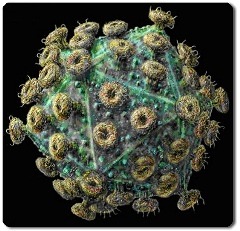
Viruses are intracellular parasites. That is to say that they need to live inside, and exploit a cell to maintain their own survival. In fact, they need to hijack a cell’s machinery in order to reproduce. In light of this semi-autonomous reproduction strategy, there is much debate as to whether viruses should be classified as living organisms, or whether they should be classified as a biological pathogen… thingy. Anyway, not the subject of this post.

Human Immunodeficiency Virus (HIV-1), a retrovirus
Viruses are basically large protein particles, with some genetic material encased within them, and a tiny amount of carbohydrates and lipid here and there. They can’t synthesise any of this themselves, so they inject or insert their own genome into their host cell, and rely on the already-present host cell enzymes to carry out the task of copying and transcribing the DNA, and turning the transcribed RNA into virus proteins. Some viruses can insert their own genome into their host genome. As in, physically stick it into their host genome so it’s part of the hosts chromosomes.

General virus life cycle
Whenever the cell divides, the daughter cells will all be virus factories too because the daughter cells will have been given viral DNA from the parent cell. The parent cell can’t always distinguish between viral DNA and its own DNA very well, so it copies all of DNA present. Viruses are freakishly devious, exploiting our own systems to enhance their survival. When a cell produces more viruses, the viruses will cause the cell to burst open, releasing viruses into the local environment to infect local cells. Sometimes, when a virus-under-construction is taking in its DNA before it sets off into the big wide world, it takes in a copy of some of its hosts DNA. The virus now has some extra DNA within it, which it will spread to the other cells it infects. This is a process known as gene piracy. Like accidentally making a pirate copy of a DVD…

Viral lysogeny - the process of a viral genome laying dormant in a cell while it divides.
An example of this is from Rous Sarcoma virus (RSV), which can cause cancer in chickens (some viruses are capable of inducing cancer, even in humans - eg. Human Papilloma Virus aka HPV. It’s why women should be entitled to the smear test. To see if they have this virus. Over 90% of cervical cancers have been linked to HPV). Early in the scientific research on this virus, scientists found a gene called src. This gene, when inserted into the host cell can trigger its transformation into a cancer cell. This is because the src gene codes for a enzyme which responds to growth factor signals and stimulates cell growth, but this viral-encoded enzyme remains switched on even in the absence of growth factors - so it’s constantly telling the cell to grow and multiply. Initially, some scientists were like ‘WE FOUND THE VIRAL CANCER GENE! HUZZAH!’ Well… not quite right.

The protein coded for by the src gene. It is a protein-Tyr kinase.
Turns out that the gene is already present in many animals, including humans - like without viral intervention. It codes for an almost identitical enzyme as the viral src, but this enzyme deactivates when it isn’t needed. What appears to have happened is that a non-cancerous form of the virus infected an animal in its early evolution, then picked up the standard src-gene via gene piracy. This gene mutated over the course of the viruses’ reproduction, and coded for a constantly activated enzyme instead - making the virus a cancer-inducing virus. Causing tumours would be advantageous for the virus as the host cell would undergo excess uncontrolled proliferation, causing more replication of virus particles. This particular type virus would be classified as a RNA tumour virus.
Viruses, hijacking the intracellular seas since…. before Jack Sparrow at least.

pocket-pirate reblogged this from captain-nitrogen-blog
 polymath4ever reblogged this from captain-nitrogen-blog
polymath4ever reblogged this from captain-nitrogen-blog davidung liked this
rotiferola liked this
swimmingupthemountain-blog-blog liked this
reoshi reblogged this from captain-nitrogen-blog
toomuugraass-blog liked this
captain-nitrogen-blog posted this